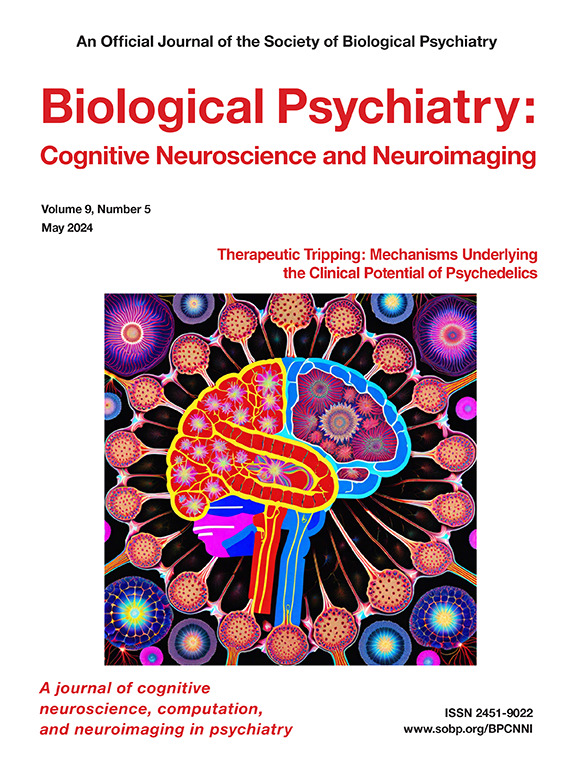Social Cognition and Functional Connectivity in Early and Chronic Schizophrenia
IF 4.8
2区 医学
Q1 NEUROSCIENCES
Biological Psychiatry-Cognitive Neuroscience and Neuroimaging
Pub Date : 2025-05-01
DOI:10.1016/j.bpsc.2024.07.024
引用次数: 0
Abstract
Background
Individuals with schizophrenia (SZ) experience impairments in social cognition that contribute to poor functional outcomes. However, mechanisms of social cognitive dysfunction in SZ remain poorly understood, which impedes the design of novel interventions to improve outcomes. In this preregistered project, we examined the representation of social cognition in the brain’s functional architecture in early and chronic SZ.
Methods
The study contains 2 parts: a confirmatory and an exploratory portion. In the confirmatory portion, we identified resting-state connectivity disruptions evident in early and chronic SZ. We performed a connectivity analysis using regions associated with social cognitive dysfunction in early and chronic SZ to test whether aberrant connectivity observed in chronic SZ (n = 47 chronic SZ and n = 52 healthy control participants) was also present in early SZ (n = 71 early SZ and n = 47 healthy control participants). In the exploratory portion, we assessed the out-of-sample generalizability and precision of predictive models of social cognition. We used machine learning to predict social cognition and established generalizability with out-of-sample testing and confound control.
Results
Results revealed decreases between the left inferior frontal gyrus and the intraparietal sulcus in early and chronic SZ, which were significantly associated with social and general cognition and global functioning in chronic SZ and with general cognition and global functioning in early SZ. Predictive modeling revealed the importance of out-of-sample evaluation and confound control.
Conclusions
This work provides insights into the functional architecture in early and chronic SZ and suggests that inferior frontal gyrus–intraparietal sulcus connectivity could be a prognostic biomarker of social impairments and a target for future interventions (e.g., neuromodulation) focused on improved social functioning.
早期和慢性精神分裂症患者的社交认知和功能连通性。
背景:精神分裂症(SZ)患者会出现社会认知障碍,从而导致不良的功能结果。然而,人们对精神分裂症患者社会认知功能障碍的机制仍然知之甚少,这阻碍了设计新型干预措施来改善预后。这个预先注册的项目(https://doi.org/10.17605/OSF.IO/JH5FC)研究了社会认知在早期和慢性 SZ 患者大脑功能结构中的表现:研究包括两个部分:确认性和探索性部分。在确认部分,我们确定了在早期和慢性 SZ 中明显存在的静息态连接中断。我们利用早期和慢性 SZ 中与社会认知功能障碍相关的区域进行了连通性分析,以检验在慢性 SZ(N=47;HC=52)中观察到的异常连通性是否也存在于早期 SZ(N=71;HC=47)中。在探索部分,我们评估了社会认知预测模型的样本外普遍性和精确性。我们使用机器学习来预测社会认知,并通过样本外测试和混淆控制来确定可推广性:结果:研究结果显示,早期和慢性 SZ 患者左侧额叶下回和顶内沟之间的减少与慢性 SZ 患者的社会认知、一般认知和整体功能显著相关,与早期 SZ 患者的一般认知和整体功能显著相关。预测模型揭示了样本外评估和混淆控制的重要性:这项研究深入揭示了早期和慢性 SZ 的功能结构,并表明 IFG-IPS 连接可能是社交障碍的预后生物标志物,也是未来干预(如神经调控)的目标,其重点是改善社交功能。
本文章由计算机程序翻译,如有差异,请以英文原文为准。
求助全文
约1分钟内获得全文
求助全文
来源期刊

Biological Psychiatry-Cognitive Neuroscience and Neuroimaging
Neuroscience-Biological Psychiatry
CiteScore
10.40
自引率
1.70%
发文量
247
审稿时长
30 days
期刊介绍:
Biological Psychiatry: Cognitive Neuroscience and Neuroimaging is an official journal of the Society for Biological Psychiatry, whose purpose is to promote excellence in scientific research and education in fields that investigate the nature, causes, mechanisms, and treatments of disorders of thought, emotion, or behavior. In accord with this mission, this peer-reviewed, rapid-publication, international journal focuses on studies using the tools and constructs of cognitive neuroscience, including the full range of non-invasive neuroimaging and human extra- and intracranial physiological recording methodologies. It publishes both basic and clinical studies, including those that incorporate genetic data, pharmacological challenges, and computational modeling approaches. The journal publishes novel results of original research which represent an important new lead or significant impact on the field. Reviews and commentaries that focus on topics of current research and interest are also encouraged.
 求助内容:
求助内容: 应助结果提醒方式:
应助结果提醒方式:


